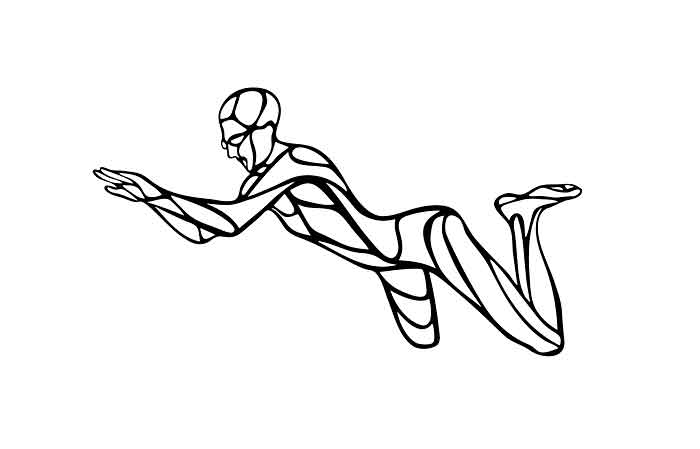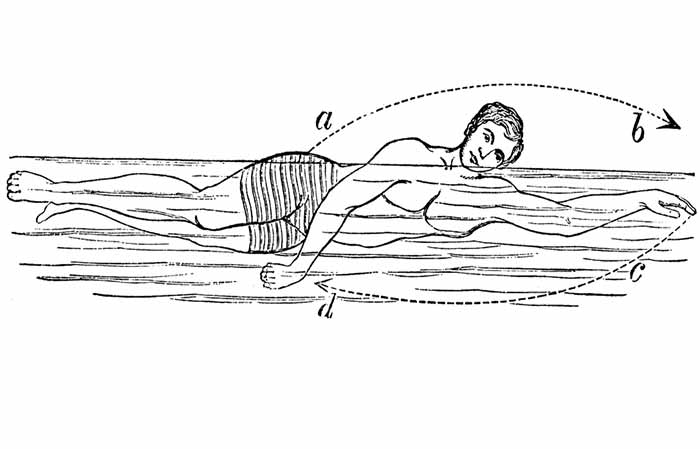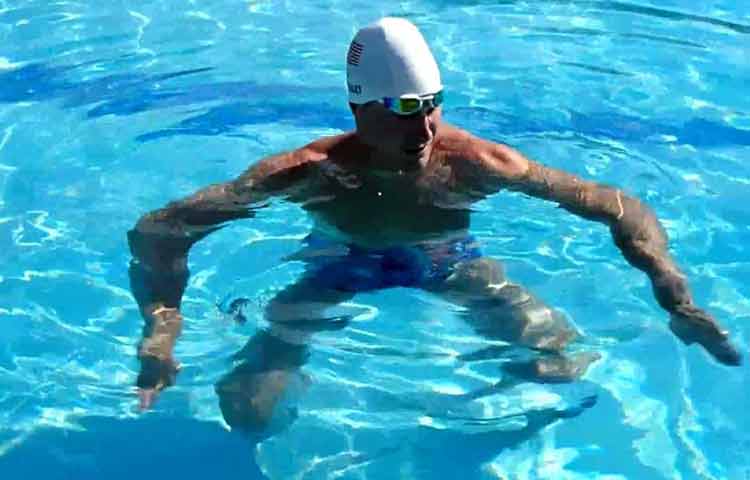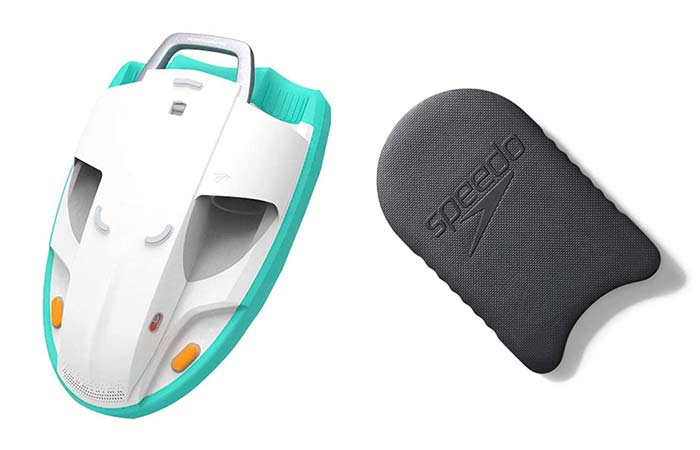Different Types of Swimming Strokes, Styles & Names
Learning how to swim is among the most beneficial skills be it for health reasons or safety. However, that alone isn’t enough to help you work with water in different situations. For example, competitions require different swimming styles and so do water currents. If you’re limited to only one swimming style, you may be at a disadvantage.
Some of the known swimming styles are the front crawl or freestyle, backstroke, breaststroke, sidestroke, butterfly, elementary backstroke, combat sidestroke, the trudgen, sculling and treading.
These swimming strokes differ in the body movements, body muscles used, speed of movement and many other aspects. Most importantly, they differ in difficulty and when they can be most suited as well.
If you’re just starting out to learn swimming, you’ll start with the simplest which is the front crawl or freestyle. After mastering this one, you can go to its various variations before embarking on the others. With improved breathing and body movements, you’ll be able to switch from one stroke to the other in no time.
Following is a list of the most common swimming types or styles with their names.
Front Crawl or Freestyle
The front crawl is the easiest yet fastest swimming method. It’s the standard swimming method given that most people start learning swimming through it.
It entails simple strokes with both hands and feet with the body lying horizontal, facing downwards. The movement for this style is always forward.
The hardest part with this style is timing the breathing with each stroke. Exhaling in most case done through the nose while facing down. Inhaling is done through your mouth when part of face is out of water.
How to Swim Freestyle: Technique, Tips & Drills
Breaststroke
Another very common swimming style is the breaststroke. This style highly mimics the jumping and swimming movements a frog. It is the oldest and yet the slowest stroke

In the early stages of learning this style of swimming, you are allowed to swim with your head above the water. As such, it’s among the easiest to learn given that the swimmer can easily breath. With breathing being among the toughest tasks when learning how to swim, this is a major advantage.
At advanced levels and swimming competitions, your head should be underwater as you glide and breath out. You get your head out to inhale at designated points in the stroke.
Unlike freestyle, when doing breaststroke, the body position changes continuously during the stroke cycle. It changes from a streamline horizontal position (after kicking), to an inclined position (for inhaling) during the arm pull.
How to Swim Breaststroke: Kick, Pull, Form, Drills & Tips
Butterfly
The butterfly stroke is among fastest swimming styles and used in lots of water competitions. It is the second fastest after front crawl.
However, it’s a very complex style to master especially if you are new swimmer.
Basically you start in a horizontal position with your stomach facing down. You move your up to breathe, your arms perform the pull.
Your legs(straight and together) perform the dolphin kick. A kick similar to how a dolphin tail moves. Your body moves in a fluid wave-like motion.
While difficult to learn, this style has its benefits as evidenced by the many medals in Mike Phelps’ cabinet. Also, the fluid movements entailed in this workout make it one of the best when it comes to working out the whole body.
How to Swim Butterfly: Technique, Drills & Tips
Backstroke
The backstroke is simply the freestyle but on your back. The movements are exactly the same but you’ll be doing so while on your back.
It’s a great exercise routine especially when you have a problem with your back. The fact that you’ll be making movements without taxing the back too much facilitates your healing process.
How to Swim Backstroke-Technique, Drills & Tips
Elementary Backstroke
Another very simple swimming style is the elementary backstroke. It’s the simpler version of the backstroke and called ‘elementary’ due to its simplistic nature. It’s among the first styles taught to children as it’s easy to grasp, allows for easy breathing and fun to perform.
The fact that you’re not coordinating any part of the body with another makes it simple enough to be done by anyone at any age. It’s another style you can use when you’re far off from the land and just want to slowly drift without using lots of energy. It’s also easy to float as long as you keep your body straight.
How to Swim Elementary Backstroke- Technique, Drills & Tips
Sidestroke
The sidestroke, while not used for competitive purposes owing to its slow nature, is an important style to learn as it can save lives. When lifeguards rescue someone drowning, they employ this style given that it allows carrying something as you swim.

Also, if you find yourself away from land and you have to swim for long, this style is quite good as it employs very little energy.
As its name suggests, it’s a style done on one side of the body. It’s another easy style to learn as your head will mostly be above the water. You start by floating your body sideways on the water.
How to Swim Sidestroke-Technique,Trudgen & Combat Drills & Tips
Combat Sidestroke
The most complex yet most efficient swimming stroke is the combat sidestroke. It’s not a pure style as such, but a combination of the sidestroke, freestyle and the breaststroke.
It was created for US Navy SEALs as it helps you save energy, move fast and reduce your profile in the water. As such, it’s a stealth type of swimming style that causes very little disturbance on the water yet very fast.
The focus is to keep the head, back and hips on a single axis even as you twist to the side and downwards.
You don’t want a pirate spotting you as you swim for a critical recuse mission if you’re a navy SEAL. All the movements happen in the water but just below the surface where there’s very little pressure.
Trudgen
The trudgen swimming stroke is another hybrid style combining the freestyle and sidestroke styles for a unique yet easy result. It’s named after the famous English swimmer John Trudgen.
This style entails majorly swimming on your side while using arms over your head and scissor kicks in every second stroke. The scissor kick occurs when you’re on your side.
As your left arm comes over your head, your legs spread in readiness for the scissor kick. As the arm comes down to the surface of the water, you do the scissor kick by pulling your legs together.
It’s very much like doing a half combat sidestroke. Given that your head will always be above the water, you’ll have lots of space to breath.
Treading Water
Treading water is a swimming technique that involves moving your arms and legs simultaneously but in an efficient way. In most cases you remain in vertical position without moving.

Just like sculling, treading is not stroke but a safety technique that beginners learn before moving to other swim strokes.It is specifically meant to make swimmers stay afloat when stopping a swim stroke in deep waters.
It is a way to relax or rest in water without having to get out. As your body is kept body afloat and your head above the surface, you can easily breathe.
There are so many ways to do tread water. However, any technique that will keep you afloat with moving while utilizing your legs and hands can be considered water treading
How to Tread Water- Techniques, Benefits & Exercises
Sculling
This a basic swimming technique in which your hands make horizontal in the water to keep your head above the water surface without sinking.
It is a fundamental safety skill that novice swimmers are taught. Professional synchronized swimming performances rely a lot on this skill as well. You can scull vertically or horizontally.
The basic sculling technique involves moving your arms, in a circular or figure-eight motion palms facing down nearly parallel to floor. This done on or just under the surface of the water, exerting pressure downward.
Do bend your elbows and keep hands in front, positioned a little bit wider than shoulders.
Sculling in Swimming: How to do it
How many Types of Swimming Strokes are there?
There are actually so many strokes but the four most common strokes are front crawl, breaststroke, backstroke and butterfly stroke.
Which is the Fastest and Slowest Stroke?
Freestyle is the fastest while breaststroke is the slowest.
To measure the speed of swimming strokes, experts in each style (usually athletes) take turns and the fastest and slowest style is recorded. With only the freestyle, backstroke, butterfly and breaststroke styles being used in swimming competitions, only these have actual speeds recorded.
In order of speed, the styles are freestyle, butterfly, backstroke and the slowest being breaststroke. It’s difficult to quantify the actual speed of hybrid styles such the trudgen and combat sidestroke. This is because they’re limited to specific classes of people and aren’t official sporting styles.
Which is the Hardest Stroke
The hardest and most tiring stroke is butterfly because it involves almost all your body muscles. However, as mentioned earlier, it is the most entertaining and best full body workout stroke
Which is the Easiest for Starters?
The easiest swim stroke is breaststroke because your head will above the water to allow easy breathing. However, this depends on an individual, some find other style easier than breaststroke.
Other Basic Swimming Strokes for Learners
Other strokes for starters include;
- Front crawl
- Elementary backstroke
- Sidestroke
Basic Swimming Skills for Beginners & Experts
As per the experts, a swimmer is only as good as their mastery of the swimming basics. These include
- Floating
- Gliding with your face under water
- Breathing techniques
- The coordination of body parts as you swim
- Diving
- Safety swimming techniques such as sculling and treading.
Besides making you a better swimmer, these skills can be the difference between life and death. Knowing to swim with one hand or with an extra load can save your life or another person’s.
Also, knowing which style is the most efficient in the moment helps navigate tough waters such as strong currents or whirlpools.
Further Reading
Following is a list of articles with more swimming information and other water sports
Swimming Strokes/Styles
Swimming FAQs & Ideas
- How Many Calories Does Treading Water Burn?
- Can you Swim with Contacts in the Ocean/Pool?
- Can you Open your Eyes in the Salty Ocean or Chlorinated Pool Waters?






